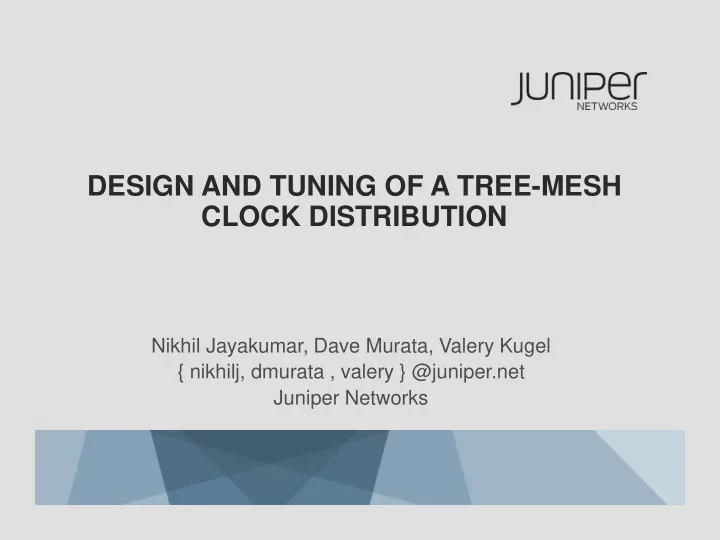

DESIGN AND TUNING OF A TREE-MESH CLOCK DISTRIBUTION Nikhil Jayakumar, Dave Murata, Valery Kugel { nikhilj, dmurata , valery } @juniper.net Juniper Networks
OVERVIEW • Comparison of Clock trees vs Clock Grids/Mesh • Juniper’s Clock distribution design overview • Juniper’s 2 step tuning flow for clock meshes • Coarse Tuning • Fine Tuning • Conclusion
CLOCK TREES VS CLOCK GRIDS STA There are 2 two kinds of clock skews Structural (layout) skew Capacitive load mismatch Handled by balanced clock trees (Eg: Htrees) Wire length mismatch • Zero / low skew only in the absence of PVT variations Skew due to PVT Two types of approaches to handle this: • Dynamic: variations • Dynamic clock deskewing schemes • Static: • Cross-link addition • Clock mesh / grid / hybrid tree-mesh Necessitates SPICE based analysis • Regular STA won’t work due to re -convergences. (more on this later….)
VERTICAL CLOCK SPINE + HORIZONTAL CLOCK RIBS Constructed to be balanced have low latency (and hence low jitter) Wire width, spacing, buffer drive strength, wire length between buffers chosen after careful simulation. Factors considered: Jitter (chose wire code for minimum jitter per unit length) Slew constraints Dynamic IR drop & EM limits Routability &area constraints Overshoot & undershoot due to inductance Cancel out PVT variations through insertion of cross-links (shorting wires) at regular intervals. Cross-links were inserted only if skew reduction outweighed jitter increase.
WHY CROSS-LINKS COMPLICATE TIMING? 0p STA cannot handle 50p re-convergence in non-linear 100p circuits. SPICE confirms the averaging 150p effect of the short, but STA 200p 395p ? cannot see this. 250p Where is the point of divergence? 350p 300p ? Need a SPICE simulation to 405p estimate delays.
JUNIPER GLOBAL CLOCK DISTRIBUTION Hybrid tree-mesh Vertical clock spine Horizontal clock ribs Balanced tree driving a mesh Core clock region Cross-links added at regular intervals in the tree also to reduce skew due to PVT Construction: PLL drives Vertical Spine Vertical Spine drives 6 Horizontal Ribs 3.1mm Horizontal Ribs drive clock mesh Technology Details: Frequency: 700Mhz to 800Mhz TSMC 40nm (45GS_1P10M_6X1Y2Z + Al RDL) Top 2 (thick) metal layers (Mz) used to distribute the core clock 17mm
WHY REDUCE SKEW IN A MESH? Q : Clock meshes reduce skew - so then why do we have to tune it? Clock meshes have an effect of averaging the delay – but at the cost of short circcuit current Large skew can result in a very large short-circuit current for drivers whose outputs are shorted Should not rely on the mesh to reduce structural skew. The mesh is used to only reduce PVT skew.
JUNIPER’S 2 STEP TUNING FLOW 1. Coarse-tuning through balancing Tuning the vertical spine and horizontal ribs through RC balancing Tuning the mesh through selective removal of horizontal cross-link wires in the mesh Based on effective wire length (capacitance) driven by each buffer 2. Fine-tuning through driver sizing Automatic driver tuning flow that sizes drivers in the vertical spine and horizontal ribs Drivers are sized to achieve uniform output delay and slew Flow can simultaneously size several thousands of buffers Manual tuning is impossible on such a scale
COARSE TUNING FLOW OF THE MESH DB with full clock mesh Remove all horizontal Mz wires of the clock mesh except the ones closest to the horizontal clock ribs Find effective length (and thus capacitance) of vertical Mz wires of clock mesh driven by each buffer Add back horizontal Mz cross-links such that total effective capacitance is equal across all output buffers Extract Clock mesh (STAR-RC) Simulate in SPICE and verify skew
FINE TUNING FLOW Buffers are sized based on Extracted netlist output slew If slew is larger than target slew, the buffer is up-sized Simulate in SPICE and gather slew and delay data proportionally to achieve target slew If slew is smaller than target Re-size buffers based on slew at output slew, the buffer is down-sized of buffers (aim is to get slew at all buffers proportionally to achieve to be uniform) target slew Simulate modified netlist (with re-sized The fine tuning flow is able to buffers) and gather slew and delay data converge to a low-skew solution within 2 to 3 iterations YES Is Buffers can be re-sized without [skew(previous_run) – re-extracting since the buffers skew (current_run)] > are designed to be footprint 1ps ? compatible NO Saves significant runtime since extraction alone can Modified netlist & DB take a day or more
RESULTS The tuning flow allowed us to reduce the structural skew of the mesh Skew was reduced to < 30ps across the whole core region and across multiple process corners (from > 100ps before tuning) The removal of the majority of the cross-links also helped save power Power consumed by the distribution (including buffers in the vertical spine + horizontal ribs) was = 1.4W for a 16mm X17mm clock mesh area at 0.9V, 800Mhz Removal of the horizontal cross-links helped reduce mesh capacitance and thus clock power by 30% Skew = 30ps Core clock area = 16mm X 17mm * Example of skew plot over an 16mm X 17mm core region
CONCLUSION We have presented a 2 step tuning flow that can de-skew and tune a clock mesh containing several thousand buffers The fine-tuning flow enables 2 to 3 iterations to be completed within 24 hours. Structural skew of more than 100ps was reduced to less than 25ps Removal of horizontal Mz cross-links in the clock mesh helped reduce clock power Clock distribution + mesh consumed a total of 1.4W in a 100W chip The removal of most of the horizontal cross-links reduced mesh capacitance and power by ~30% This tuning flow was used in multiple chips across two technology generations
Thank You
Recommend
More recommend